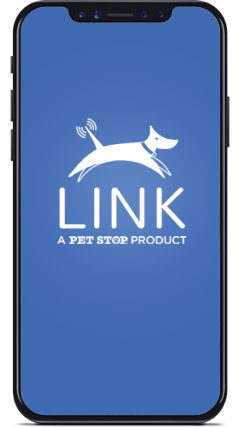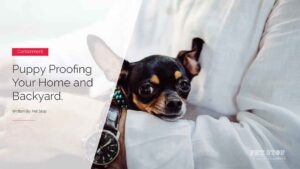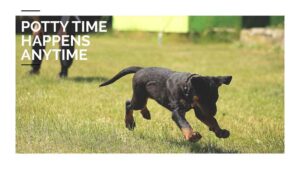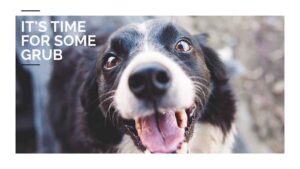25 Ways to Puppy
Training
Congratulations! You took the puppy plunge and are now a proud dog owner. Or, you finally found the perfect pup for your family, and are just days away from bringing him home. Puppy ownership has been compared to the early days of parenthood, and this is not far from the truth. Late, sometimes sleepless nights, finding the right pet fence, listening to crying and whining, ruined clothes and furniture, accidents happening anywhere and everywhere, teething- all of these things are just bumps on the road to having a long-term, wonderful canine companion. Here are 25 “bites” of advice to help make this transition as smooth as possible, for both you and your new pup!
Puppy Proofing
1) Before he arrives, puppy-proof your home. Walk through your puppy proof house or apartment and make sure cleaning products are safely secured in cabinets, electrical outlets are covered, decorative knick-knacks are moved to higher ground, and any medication is put away. Child-proof lids are no match for a curious, teething puppy. If you have a garage, make sure to put the antifreeze far, far away: it is fatal if ingested. Typically, the younger you start your fur baby the better when it comes to boundary training. Check out our homepage for more information on underground or wireless fences that seem invisible!
Puppy Fencing
2) Test out your fence for any weak spots, and secure your pool area. Although they can swim, drowning can happen. Be mindful that a pup only needs a bit of wiggle room to free himself from your yard, so don’t overlook this important step.
Establish the Rules
3) Pre-establish rules for the puppy with the entire household. Rules such as not letting the pup jump on you, or sleep in your bed, or eat from the table need to be decided and agreed-upon before your furry bundle of joy steps paw into your home.
Create a Routine
4) Pre-establish a routine for the puppy before he arrives. Your new pup will likely suffer from some separation anxiety and need structure in order to assimilate quickly to his new digs. Decide now who will feed him, walk him, clean up after him, etc.
Vaccination Schedule
5) Once your dog is home, take him to your vet to find out how best to make your pup feel comfortable. Your vet knows dog temperaments and behaviors and can advise you on a vaccination schedule, and when he is allowed outside.[1]
Puppy Training
6) Schedule socialization classes, a.k.a.” puppy kindergarten” right away. Many community centers and pet stores offer these classes year-round. He may not be ready for it right away, but get it on the books! Don’t forget the important steps during leash and off-leash training. This will come in handy later!
Puppy Potty Training
7) Puppies need to “go potty” every 30-45 minutes while they are awake. Create a toilet area for him and reward him when he goes there.
8) His potty area should be a confined space, such as a bathroom, or inside an exercise pen. This will help reinforce his “den behavior” that tells him where to go. Keep the bathroom door open for easy access.
9) Keep a diary of your pup’s potty habits. This will help you better anticipate potential accidents.
10) Never, ever punish a puppy for a potty mistake.
11) If you catch your pup peeing in the “wrong” area, gently and quickly scoop him up and move him to his toilet area. Note: this does NOT work with a pooping pup!
12) Puppies will give NO warning that they are about to potty. They can give you a few clues that they are about to poop, however, such as sniffing or circling a particular area. Pay attention to your pup!
Puppy Feeding
13) Keep a strict feeding schedule to facilitate a predictable potty schedule. You will soon be able to anticipate when your dog needs to go, whether it is immediately or 30 minutes after his feeding.
14) Do not “free feed.” You need to establish yourself as the alpha/pack leader (more about this in a bit) who provides the food, so a set mealtime is crucial.
15) Make sure the puppy’s toilet area is quickly and easily accessible to him.
Bed Time
16) Use your own bedtime and wake time to train your pup. Before you go to sleep, and right when you wake, carry the puppy to the designated toileting area. Praise and reward him when he goes potty here.
17) Always reward for good behavior; it’s THE key to successful training.
Other Important Training Habits
18) To help curtail biting, socialize your pup with other dogs on a regular basis. Socializing provides the input he needs from other dogs, especially if he was separated from his litter at an early age. Frequent dog parks, dog beaches, and take obedience classes.
19) Dogs must learn to inhibit their biting by four months old. Dog-to-dog socialization will teach them both appropriate behavior AND how not to fear other dogs.
20) As with potty training, do not reprimand your puppy for biting. Hitting your dog will erode his trust in you, and lead to possible bad behavior. You need to earn his trust and respect. The love, however, is unconditional.
21) When puppies bite their humans, it’s because they think you are their littermate. The remedy for this is, as previously suggested, lots of doggie socialization.
22) Help curtail your puppy’s chewing by lavishing praise on him when you see him chewing on an appropriate toy.
23) Dogs usually do the most inappropriate chewing right before you return home from work. The anticipation makes them a little anxious, and they release it through chewing. One solution: teach your dog to greet you with one of their toys in their mouth. Reward and praise this behavior.
24) If you come home and your puppy has chewed something that is NOT a toy, do not punish him. Realize that he became bored and restless while you were out, and he can be trained out of this behavior.
25) Make a special indoor “digging pit” for your puppy’s toys, to provide safe and fun exploration. Soak a favorite rawhide or marrow bone in some soup, let it dry, and then place it at the bottom of a dog toy chest. Ensure that there is a variety of enticing, engaging dog toys in your home.
[1] http://www.perfectpaws.com/frstwk.html#.WYs521GGOUk
 Pet Stop
Pet Stop Get a Free Quote
Connect with Your Local Pet Safety Experts at Pet Stop. Visit, call, or
chat with us – we’re here to help you create the ultimate safe haven for your pet.
Get a Free quote
Name *
Zip code where new fence is required *
What breed is your dog?
Preferred contact method *
Phone Number to Call/Text *
Address *
Stay Connected, Stay in Control
Brief introduction to the OT-300, highlighting remote control, real-time notifications, and easy setup through the Pet Stop Link App.
Download the App


